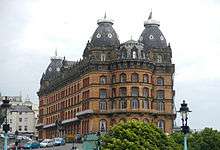Cuthbert Brodrick
| Cuthbert Brodrick | |
|---|---|
|
Cuthbert Brodrick | |
| Born |
1821 Kingston upon Hull |
| Died |
1905 Jersey, Channel Islands |
| Occupation | Architect |
| Buildings | Leeds Town Hall, Grand Hotel, Scarborough |
Cuthbert Brodrick FRIBA (1 December 1821 – 2 March 1905) was a British architect, whose most famous building is Leeds Town Hall.



Early life
Brodrick was born in the Yorkshire port of Hull where his father was a well-to-do merchant and shipowner. He was the sixth son of ten children of John and Hannah Brodrick. The family lived at 39 George Street in the best residential area of Hull.
Education and training
Brodrick attended Kingston College in Hull and, on leaving school, he became an articled pupil in the architectural practice of Henry Francis Lockwood whose premises were at 8 Dock Street. Brodrick remained at Lockwoods from 1837 until May 1844 when he embarked on the Grand Tour to continue his studies. He travelled through France to Rome in Italy. Whilst on the tour he studied the architecture of Second Empire in Paris which influenced his later designs.[1]
When Brodrick returned to Hull in 1846, he was offered a partnership in Lockwood’s firm. He refused this, and set up in practice on his own at 1, Savile Street in Hull. He designed a number of local buildings in Hull including the Hull Royal Institution building and the Hull Town Hall.
Leeds
In 1852, aged 29, Brodrick entered and won a competition for the design of Leeds Town Hall. The competition was judged by Charles Barry. The town hall was opened in September 1858 by Queen Victoria. Brodrick moved to an office at 30 Park Row, Leeds and acquired the nickname 'Town Hall, Leeds'. The iconic clock tower, which serves as a symbol of Leeds, was not part of Brodrick's initial design but was added when the civic leaders sought an even grander architectural statement.
His other important buildings in Leeds were the Leeds Corn Exchange (1860-3) and the Mechanic's Institute (1860-5) which became the Civic Theatre and in September 2008 the home of the Leeds City Museum. He altered the way central Leeds looked with just three buildings.
Notable buildings
Leeds
- Leeds Town Hall, 1858
- Leeds Corn Exchange, 1860
- The Mechanic's Institute, 1860 (later Civic Theatre and now Leeds City Museum)
- The Oriental Baths in Cookridge Street, 1866 (demolished)
- King Street Warehouses, 1862 (demolished)
- Headingley Hill Congregational church, 1864 (now known as the Ashwood Centre and used by City Church Leeds)[2]
- Moorland Terrace, 1859 (demolished)
- 7 Alma Road, 1859
- 49-51 Cookridge Street, 1864
Elsewhere

Brodrick designed the Grand Hotel in Scarborough.[3] [4]
He submitted unsuccessful designs in competitions to build Preston Town Hall, and the Exchange in Manchester.
Personal life
In 1870, Brodrick moved to France where in 1876 he bought a house at Le Vésinet, St. Germain-en-Laye. He retired in 1875, and spent his time painting, exhibiting his work and gardening. In about 1898 he went to live with his niece in Jersey, where he rented a house, La Colline, at Gorey. Whilst living there he designed, and planted a garden.[5] He died in Jersey on 2 March 1905, and is buried in St Martin's Churchyard. [6]
Pupils
Among Brodrick's pupils was Joseph Wright (architect)
Legacy
A Wetherspoons public house, the 'Cuthbert Brodrick', opened on 22 October 2007 on Millennium Square in Leeds opposite one of the buildings he designed (the Leeds City Museum) and not far from another (Leeds Town Hall).[7] It is near the site on Cookridge Street of the Oriental Baths which he also designed; they were built in 1866 and demolished in 1969.[8] His nephew was F. S. Brodrick, also an architect worked with R. G. Smith.
Brodrick was the subject of a 2007 BBC2 television programme The Case of the Disappearing Architect by Jonathan Meades.[9]
References
- ↑ "BBC - Leeds - How We Built Britain - Cuthbert Broderick". www.bbc.co.uk. Retrieved 2009-08-24.
- ↑ "The Building – the bricks & mortar". City Church Leeds. Retrieved 2010-10-04.
- ↑ "BBC - Legacies - Architectural Heritage - England - Leeds - A bolt out of the blue - Article Page 1". www.bbc.co.uk. Retrieved 2009-08-24.
- ↑ Grand Hotels: Reality and Illusion - Google Books. books.google.co.uk. Retrieved 2009-08-24.
- ↑ "Ancestry.co.uk - 1901 Channel Islands Census". search.ancestry.co.uk. Retrieved 2009-08-25.
- ↑ Directory of British Architects 1834 ... - Google Books. books.google.co.uk. Retrieved 2009-08-24.
- ↑ "The Cuthbert Brodrick, Leeds - Leeds City Guide - The Essential Guide to Bars, Pubs, Clubs, Hotels and Restaurants in Leeds.". www.leeds-city-guide.com. Retrieved 2009-08-25.
- ↑ Leach, Peter; Pevsner, Nikolaus (2009). Yorkshire West Riding: Leeds, Bradford and the North. New Haven and London: Yale University Press. p. 448. ISBN 978-0-300-12665-5.
- ↑ "The Case of the Disappearing Architect". BBC 2. Retrieved 29 August 2011.
